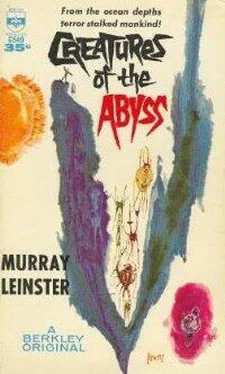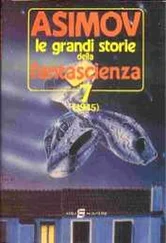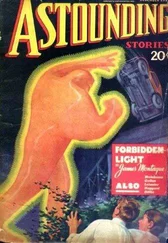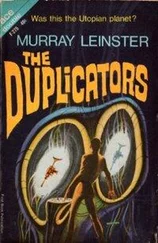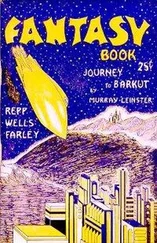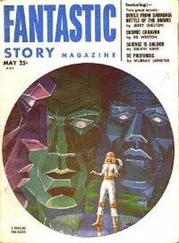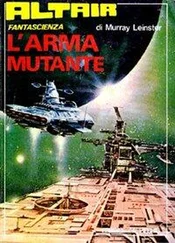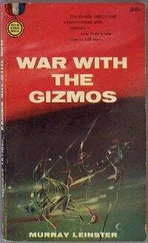La Rubia continued to try to catch fish. They were here in plenty. But the coral heads were everywhere. Nets tore. Ropes parted. Capitan Saavedra waved his arms and swore.
The Esperance rumbled and circled away from the wharf, and headed for the lagoon entrance. The singular contrivance built during the night was in place at her bow. She passed La Rubia, on whose deck men frantically mended nets.
The Esperance passed between the small capes and the first of the ocean swells raised her bow and rocked her. She proceeded beyond the reef. The bottom of the sea dropped out of sight. Terry switched on the submarine ear and listened. The humming sound was to be expected here.
It had stopped. It was present yesterday, and even during the night, when La Rubia came into the lagoon. But now the sea held no sound other than the multitudinous random noises of fish and the washing, roaring, booming of the surf.
Deirdre was aboard, of course. She watched Terry’s face. He turned to the new instrument, and then dropped his hand.
“I think,” he said carefully to Davis, “that I’d like to make a sort of sweep out to sea. It’s just possible we’ll find the hum farther out.”
Deirdre said quickly, “I think I know what you’re up to. You want to survey a large area of the ocean while something comes up. Then you can direct that “something” to the lagoon mouth by using your sound device, so the … whatever-it-is has to take refuge in the lagoon. Since we’ve killed the squid… ”
“That’s it,” said Terry. “Something like that happened when we speared the fish. The squid took their place. Now we’ve killed the squid. Just possibly…”
They found the humming sound in the water four miles offshore. They traced it through part of a circle. If something were being driven upward, it could not pass through that wall of humming sound.
“That proves your point,” Davis said. “Now what?”
Without realizing it, he’d yielded direction of the enterprise to Terry, who had unconsciously assumed it.
“Let’s go back to the island,” said Terry thoughtfully. “I’ve got a crazy idea—really crazy! I want to be where we can duck into shallow water when we try the new projector.”
The Esperance swung about and headed back toward the island. The sea and the distant island looked comfortingly normal and beautiful in the sunshine. Under so blue a sky it did not seem reasonable to worry about anything. Events or schemes at the bottom of the sea seemed certainly the last things to be likely to matter to anyone.
Terry had the Esperance almost between the reefs before he tried the new contrivance. If it worked, it should be possible to make a relief map of the ocean bottom with every height and depth on the seabed plotted with precision.
He started to operate the new instrument. First he traced the steep descent from the flanks of the submarine mountain whose tip was Thrawn Island. He traced them down to the abyss which was the Luzon Deep. Then he began to trace the ocean bottom at its extreme depth, on what should have been submarine plains at the foot of the submerged mountain. The instrument began to give extraordinary readings. The bottom, in a certain spot, read forty-five hundred fathoms down. But suddenly there was a reading of twenty-five hundred. There was a huge obstruction, twelve thousand feet above the bottom of the sea, more than twenty thousand feet below the surface. The instrument scanned the area. Something else was found eighteen hundred fathoms up. These were objects of enormous size, floating, or perhaps swimming in the blackness. They were not whales. Whales are air-breathers. They cannot stay too long in deep waters, motionless between the top and the bottom of the sea.
The instrument picked up more and more such objects. Some were twenty-five hundred fathoms from the bottom, and two thousand from the surface. Some were twenty-two hundred up, and twenty-three hundred down. There were eighteen hundred-fathom readings, and twenty-one, and twenty-four, and nineteen. The readings were of objects bigger than whales. They rose very slowly, and appeared to rest, then rose some more, and rested…
Blank faces turned to Terry. He licked his lips and looked for Deirdre. Then he said evenly, “We go into the lagoon. And if we come out again—if!—we leave Deirdre ashore, unless these readings have been cleared up. There are chances I’m not willing to take.”
The Esperance headed in. It was not possible for the new instrument to tell what the large objects were. They could be monstrous living creatures, perhaps squids, and one could only guess that their errand was to deal with the surface-creatures—men—who speared fish and giant squids and set off explosions in the Luzon Deep.
Or the rising objects could be, say, bolides which had dived into the Deep from outer space and were now coming to the surface to make sure that the natives of the earth did not again disturb the depths taken over by beings from another planet.
The sun rose high in the sky as the Esperance returned to the wharf. Davis went ashore and held lengthy conversations with Manila by short-wave radio. The biologists essayed to investigate the squid. La Rubia still attempted to catch fish. All efforts seemed to tend toward frustration.
When Terry walked over to see his victim at close range, he found the biologists balked by the mere huge size of the squid. There were literally tens of tons of flesh to be handled. Squid have no backbone, but a modified internal shell is important to biologists for study. The biologists wanted it. The gills needed to be examined, and their position under the mantle noted, and their filaments counted. The nervous system of the huge creature must have its oddities. But the actual preservation of the squid was out of the question. The mere handling of so large an object was an engineering problem.
Terry consulted the frenziedly swearing Capitan Saavedra, who was ready to weep with sheer rage as he contemplated torn nets, and fish he could not capture. Squids were an article of commerce. Terry took the Capitan to view this one. His crew would help the biologists get at the scientifically important items, and for reward they would have the rest of the giant—more than they could load upon La Rubia. This would make their voyage profitable, and the Capitan would have the opportunity to tell the most stupendous story of his capture and killing of the giant. With the evidence he’d have, people might believe him.
Presently, the crewmen of La Rubia clambered over the monster, huge knives at work under the direction of the men from Manila. There was bitter dispute with the tracking station cook, who objected to the use of his refrigeration space to freeze biological material before it was sent to Manila by helicopter.
In mid-afternoon the Esperance left the lagoon again. The sonar-depth-finder probed the depths delicately. The objects in mid-sea, it appeared, had been rising steadily. Their previous position had averaged twenty-five hundred fathoms deep. They were now less than two thousand fathoms down, and there were many of them. Unfortunately, the Esperance was not a steady enough platform for the instrument. But a fairly accurate calculation was made, and if the unidentified objects continued their ascent at their present rate, they would surface not long after sunrise. Then what?
Increasingly urgent queries came by short-wave, asking for Dr. Morton’s explanation of how he had computed the landing place and time of the latest bolide. His accuracy was not disputed. But astronomers and physicists wanted to be able to do it themselves. How had he done it?
Читать дальше
